
Rani Andaleeb
''During childhood, the cold wave was so severe that the mother used to wear thick clothes as well as woolen vests, socks, and caps. The rooms used to have heaters and it rained every other day, but now the cold season starts late and ends early.
In my early years, the biting cold compelled my mother to don layers of warm clothing, from thick garments to woolen vests, socks, and caps. Our rooms were heated, and rain was a frequent companion. However, the cold season's onset has shifted, now arriving later and bidding adieu sooner.''
Seema, who belongs to Nowshera, said that the way she spent the winter season as a child and in the olden days when there was only greenery everywhere, the future generations may not be able to see all this. Trees are being felled indiscriminately, along with the formation of societies on arable land, which is not only polluting the clean environment but also contributing to the destruction of the climate.
Seema, hailing from Nowshera, laments that the idyllic winters of her childhood, marked by lush greenery, may become a rarity for future generations. Rampant deforestation and urbanization on fertile lands not only mar the pristine environment but also hasten climate degradation.
On the other hand, Maryam, a resident of Peshawar, said that now the winter season has reduced so much that it starts from December and ends by February 15. Earlier, the weather was quite pleasant from September 15, while it turned cold in October. Winter clothes are also not worn heavily anymore, it seems that in a few years, the era of sweaters and socks will also end.
Also Read: Policing Perils: Overhauling Strategies Amid Rising Terrorism Threats
Contrastingly, Maryam from Peshawar observes a considerable reduction in the winter season, commencing in December and concluding by mid-February. In earlier times, pleasant weather graced the region from mid-September, gradually transitioning to colder temperatures in October. The era of heavily layered winter clothing, including sweaters and socks, appears to be waning.
Peshawar Sadar Bazaar shopkeeper Raza Khan agreed with Maryam and said that he has been involved in the cloth business for the past 45 years. 20 or 30 years ago, the business of warm clothes is now gone. There is very little business, people often laugh where is the cool? Show light clothes!
Raza Khan, a shopkeeper in Peshawar Sadar Bazaar, aligns with Maryam's perspective, noting a stark change in the demand for warm clothing over his 45-year tenure in the cloth business. The thriving trade in warm clothes that once prevailed two or three decades ago has dwindled significantly. Nowadays, customers jest, questioning the need for heavier clothing and urging the display of lighter garments.
What is climate change?
The climate of a region or region is the average of its weather over many years. Climate change refers to changes in this average. Earth is now going through a period of rapid climate change, and global temperatures are rising. The change in temperature of any region or country over 10 to 20 years is called climate change. 10 countries are being affected the most by the damages of climate change, in which Pakistan is number seven.
The climate of a region is the cumulative average of its weather over numerous years, and climate change denotes alterations in this average. Earth presently grapples with swift climate change, witnessing a surge in global temperatures. The shift in a region or country's temperature over a 10 to 20-year span defines climate change. Pakistan ranks seventh among the ten countries most impacted by the repercussions of climate change.
Dr. Muhammad Akmal, the former Director of Climate Change and Chairman of Agricultural University Peshawar, said that today the Earth is at a point in its orbit where the Northern Hemisphere is facing away from the Sun and the Southern Hemisphere is facing the Sun. Because of this, it is getting cold in the Northern Hemisphere and it is getting hot in the Northern Hemisphere.
Dr. Muhammad Akmal, the former Director of Climate Change and Chairman of Agricultural University Peshawar, explicates that the Earth's current orbital alignment places the Northern Hemisphere away from the Sun, inducing cold conditions, while the Southern Hemisphere basks in warmth.
Regarding why the cold has decreased and the heat has intensified since 1980, Dr. Akmal further said that the simple answer is that we see that on the one hand, there is a lot of construction work in countries around the world, on the other hand. If you look at the climatic situation of Pakistan, from 1960 to 1990, which is 30 years, or from 1990 to 2010 or 20, which is 60 years of data, the winds have also changed. With the change in the wind, the direction of the clouds also changes. As the clouds change direction, the accompanying rain system, which used to occur in winter, has now slowly moved into summer. Monsoon rains that used to occur have now arrived by May.
Dr. Akmal elaborates on the decrease in cold and the intensification of heat since 1980, attributing it to global construction activities and alterations in wind patterns. In the context of Pakistan's climate from 1960 to 1990, 30 years, and from 1990 to 2010, 20 years, shifts in wind patterns are apparent. This change in wind direction influences cloud movements, leading to a transformation in the traditional winter rain system, gradually shifting it towards summer. Monsoon rains, once slated for June and July, now make their appearance as early as May.
According to Dr. Akmal, the climate of Pakistan, and especially Khyber Pakhtunkhwa, has also changed. The streak of rain in September, October, November, December, and January is gradually moving towards the second month. And the rains that used to occur in June and July have now changed to March. The same rains will occur eight or ten years from now in February. So this is affecting the winters and in the future too, the winters will be dry and there will be no rain. And when there are no rains, the temperature will rise, and the weather will be dry and hot. The duration of winter will be shorter, and hence people who used to wear thick clothes will not wear thick clothes or sweaters anymore. He said that due to climate change, the winter season has also changed and reduced, which has also reduced the demand for warm clothes.
Dr. Akmal contends that the climate of Pakistan, particularly Khyber Pakhtunkhwa, has transformed. The traditional rainfall pattern from September to January is gradually shifting into the following month. Additionally, the rains that once graced June and July have now advanced to March. This pattern is expected to persist, with similar rains projected to occur in February eight or ten years hence. These alterations impact winters, making them drier, with reduced precipitation. The declining demand for warm clothing is a direct consequence of these shifts in the winter season due to climate change.
1.jpeg)
.jpeg)
01 Jul, 2025

.jpeg)


